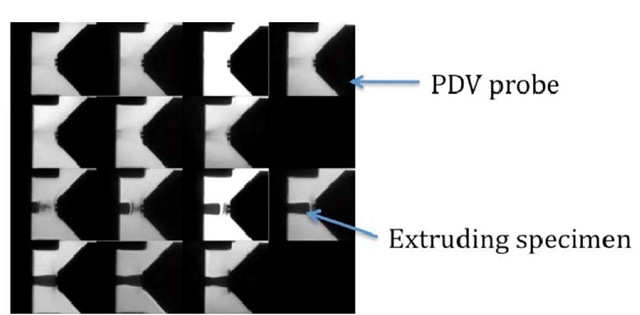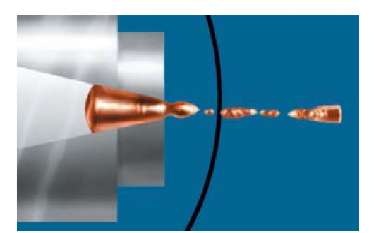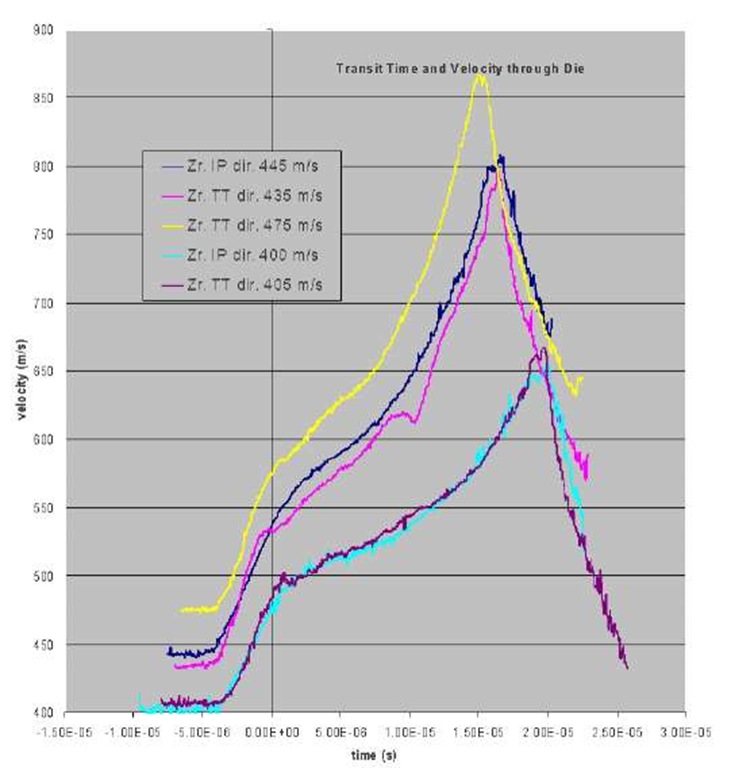Extended Abstract
The effect of high strain-rate and high strains on mechanical behavior has been observed primarily in isotropic, cubic materials. The behavior of low-symmetry, textured, materials is not as well understood. To examine the high strain and high strain-rate response of structural metals, a Dynamic Tensile Extrusion technique has been developed at Los Alamos National Laboratory. In this study, high-purity zirconium bullets were accelerated up to velocities of 615m/s and extruded through a high-strength steel die. The Zr bullets were fired at 23°C and 250°C. Specimens were sectioned in two orthogonal directions from the as received plate: (1) loading direction aligned in plane (IP) to the rolling direction and (2) loading direction through thickness (TT) of the plate. A combination of in-situ and ex-situ characterization techniques has been used to study the response of Zr under this dynamic loading condition. Not only are these the first experiments of their kind performed at temperatures higher than room temperature, but high-speed imaging and for the first time, PDV (Photonic Doppler Velocimetry) has been employed to capture the time and velocity of the evolved deformation through the die.
In the Dynamic Tensile Extrusion technique, an 81° die is rigidly affixed to the end of a 0.300 caliber barrel [1]. The die is ~ 7 / times the reduction in cross-sectional area. At velocities of several hundred meters per second, this dynamic event produces an oblique shock match of several GPa of pressure and associated shear. This strongly integrated test results in a wide range of strain rates and stress states within the test specimen. However, a significant component to the stress state is tension, allowing us to investigate dynamic tensile failure modes.
Using PDV in a novel application, we can generate valuable data sets that will provide validation and assist in developing fracture models. This diagnostics technique relies on an optical probe and a 1550nm wavelength laser (components of the PDV system). With this system, reflected light, from the front surface of the accelerating and extruding sample, can be captured by the probe as it travels through the barrel and then into the die. However, for this to be possible, the probe must be precisely aligned along the axis of thebarrel and the die. In Fig. 1, a high speed image, taken at 2^s interframe times, are captured as the extruded sample is approaching the optical probe of the PDV system. Using this diagnostic, we can capture the samples transit time through the die as well as the velocity profile during this transition. The die transit time is directly utilized to inform the continuum level of processing time of the material in the die so constitutive models can further evaluate the measured behavior. Computationally, the projectile is allowed to "slip" thru the die via slide lines or interfacial slip and shear – both of which are approximations. If the transit time is accurately captured in the modeling, it is likely that the calculated pressures, strains, stresses, etc. realized by the projectile as a function of time may be more reasonable approximations. To validate this further, predictions of the ultimate segmentation of the extruded specimen, shown in Fig.2, can be compared with tested and soft recover specimens. As is evident in Fig. 1, we witness the tensile instability in the necking of the sample before impacting the probe. This leads to segments of the extruded specimen but also results in a "tensile pullback". This is captured for the first time through the time and distance measurements of the PDV, Fig. 3.
From soft recovered extruded specimens, post mortem characterization could be performed and correlations based on the influence of texture, temperature and test velocity on ductility could be made. We found that the In Plane samples consistently show larger elongations than Through Thickness specimens, by about 25%. Elongations were measured based on the total length of reassembled, soft recovered, extruded pieces. Reassembly of fully extruded segments was based on the high speed camera images that captured the in-situ damage process. For all tests, a segment of the dynamically loaded specimen remained in the die. For many of these tests, this piece was removed and microstructural analysis was performed. This analysis included: optically microscopy (OM), scanning electron microscopy (SEM), and electron back scattered diffraction (EBSD). In the In Plane cases, texture evolution due to the dynamic extrusion process was not as significant as that observed in the TT case. This correlated well with differences in observed twinning. More tensile twinning was observed in the TT specimens, as may be expected for Zr loaded in this orientation in a stress state dominated by tensile loads [2]. This difference in twinning is expected to generate differences in the development of plastic instabilities during deformation and is likely linked to observed difference in elongation between IP and TT specimens. Quantitative examination of the influence of temperature, texture, and extrusion velocity will be presented as well as PDV findings on transit times through the die.
Figure 1: High speed photography of the extruding specimen approaching the PDV probe
Figure 2: Optical image of a soft recovered and reassembled extrusion specimen. Schematically the die was added to the image to aid in description of fully extruded versus segment left in the die
Figure 3: Example of the in-situ PDV data collected during a dynamic extrusion experiment. This data clearly demonstrates the "tensile pull back" phenomenon. The peak is the front of the sample as it exits the die.



